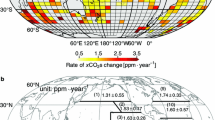Abstract
Seawater samples were collected in the North Pacific along 175°E during a cruise of the Northwest Pacific Carbon Cycle Study (NOPACCS) program in 1994. Many properties related to the carbonate system were analyzed. By using well-known ratios to correct for chemical changes in seawater, the CO2 concentration at a given depth was back calculated to its initial concentration at the time when the water left the surface in winter. We estimated sea-surface CO2 and titration alkalinity (TA) in present-day winter, from which we evaluated the degree of air-sea CO2 disequilibrium in winter was. Using a correction factor for air-sea CO2 disequilibrium in winter, we reconstructed sea-surface CO2 in pre-industrial times. The difference between the back-calculated initial CO2 and sea-surface CO2 in pre-industrial times should correspond to anthropgenic CO2 input. Although the mixing of different water masses may cause systematic error in the calculation, we found that the nonlinear effect induced by the mixing of different water masses was negligible in the upper layer of the North Pacific subtropical gyre along 175°E. The results of our improved method of assessing the distribution of anthropogenic CO2 in that region show marked differences from those obtained using the previous back-calculation method.
Similar content being viewed by others
References
Anderson, L. A. and J. L. Sarmiento (1994): Redfield ratios of remineralization determined by nutrient data analysis. Global Biogeochem. Cycles, 81, 65–80.
Brewer, P. G. (1978): Direct observation of the oceanic CO2 increase. Geophys. Res. Lett., 5, 997–1000.
Chen, C.-T. A. (1982): Oceanic penetration of excessCO2 in a cross section between Alaska and Hawaii. Geophys. Res. Lett., 9, 117–119.
Chen, C.-T. A. (1993): Anthropogenic CO2 distribution in the North Pacific Ocean. J. Oceanogr., 49, 257–270.
Chen, C.-T. A. and F. J. Millero (1979): Gradual increase of oceanic carbon dioxide. Nature, 277, 205–206.
Chen, C.-T. A. and R. M. Pytkowicz (1979): On the total CO2-titration alkalinity-oxygen system in the Pacific Ocean. Nature, 281, 362–365.
Department of Energy (DOE) (1991): Handbook of methods for the analysis of various parameters of the carbon dioxide system in sea water, version 1. U.S. DOE SGRP–89–7A, ed. by A. G. Dickson and C. Goyet, Scripps Institution of Oceanography.
Enting, I. G. and J. V. Mansbridge (1991): Latitudinal distribution of sources and sinks of CO2: Results of an inversion study. Tellus, 43, 156–170.
Friedli, H., H. Loetscher, H. Oeschger, U. Siegenthaler and B. Stauffer (1986): Ice core record of the 13C/12C record of atmospheric CO2 in the past two centuries. Nature, 324, 237–238.
Gamo, T. and Y. Horibe (1980): Precise determination of dissolved gases in water by shipboard gas chromatography. Bull. Chem. Soc. Jpn., 53, 2839–2842.
Goyet, C., C. Beauverger, C. Brunet and A. Poisson (1991): Distribution of carbon dioxide partial pressure in surface waters of the Southwest Indian Ocean. Tellus, 43B, 1–11.
Gruber, N., J. L. Sarmiento and T. F. Stocker (1996): An improved method for detecting anthropogenic CO2 in the oceans. Global Biogeochem. Cycles, 104, 809–837.
Inoue, H. Y., H. Matsueda, M. Ishii, K. Fushimi, M. Hirota, I. Asanuma and Y. Takasugi (1995): Long-term trend of the partial pressure of carbon dioxide (pCO2) in surface waters of the western North Pacific, 1984–1993. Tellus, 47B, 391–413.
Keeling, C. D., S. C. Piper and M. Heimann (1989): A three dimensional model of atmospheric CO2 transport based on observed winds, 4, Mean annual gradients and interannual variations. p. 305–363. In Aspects of Climate Variability in the Pacific and Western Americas, Geophys. Monogr. Ser., Vol. 55, ed. by D. H. Peterson, AGU, Washington, D.C.
Millero, F. J., K. Lee and M. Roche (1998): Distribution of alkalinity in the surface waters of the major oceans. Mar. Chem., 60, 111–130.
Neftel, A., E. Moor, H. Oeschger and B. Stauffer (1985): Evidence from polar ice core measurements give atmospheric CO2 in the past two centuries. Nature, 315, 45–47.
Quay, P. D., B. Tilbrook and C. S. Wong (1992): Oceanic uptake of fossil fuel CO2: Carbon—13 evidence. Science, 256, 74–79.
Redfield, A. C., B. J. Ketchum and F. A. Richards (1963): The influence of organisms on the composition of sea water. p. 26–77. In The Sea, Vol. 2, ed. by M. N. Hill, Interscience, New York.
Robertson, J. E. and A. J. Watson (1992): Thermal skin effect of the surface ocean and its implications for CO2 uptake. Nature, 358, 738–740.
Sarmiento, J. L. and E. T. Sandquist (1992): Revised budget for the oceanic uptake of anthropogenic carbon dioxide. Nature, 356, 589–593.
Sarmiento, J. L., J. C. Orr and U. Siegenthaler (1992): A perturbation simulation of CO2 uptake in an ocean general circulation model. J. Geophys. Res., 97,C3, 3621–3645.
Shiller, A. M. (1981): Calculating the oceanic CO2 increase: A need for caution. J. Geophys. Res., 86,C11, 11083–11088.
Takahashi, T., W. S. Broecker and S. Langer (1985): Redfield ratios based on chemical data from isopyenal surfaces. J. Geophys. Res., 90, 6907–6924.
Takahashi, T., J. Olaffson, J. G. Goddard, D. W. Chipman and S. C. Sutherland (1993): Seasonal variation of CO2 and nutrients in the high-latitude surface oceans: A comparative study. Global Biogeochem. Cycles, 7,4, 843–878.
Tans, P. P., I. Y. Fung and T. Takahashi (1990): Observational constraints on the global atmospheric CO2 budget. Science, 247, 1431–1438.
Tsunogai, S., T. Ono and S. Watanabe (1993): Increase in total carbonate in the Western North Pacific Water and a hypothesis on the missing sink of anthropogenic carbon. J. Oceanogr., 49, 305–315.
Watanabe, Y. W., Y. Takahashi, T. Kitao and K. Harada (1996): Total amount of oceanic excess CO2 taken from the North Pacific subpolar region. J. Oceanogr., 52, 301–312.
Weiss, R. F. and H. Craig (1973): Precise shipboard determination of dissolved nitrogen, oxygen, argon, and total inorganic carbon by gas chromatography. Deep-Sea Res., 20, 291–303.
Author information
Authors and Affiliations
Rights and permissions
About this article
Cite this article
Takahashi, Y., Matsumoto, E. & Watanabe, Y.W. Improved Method for Calculating Anthropogenic CO2 in the Upper Layer of the North Pacific Subtropical Gyre along 175°E. Journal of Oceanography 55, 717–729 (1999). https://doi.org/10.1023/A:1007820330520
Issue Date:
DOI: https://doi.org/10.1023/A:1007820330520




